Magnetic Effects of Electric Current Class 10 Important Questions and Answers
Important Questions for Class 10 Science Chapter 13 Magnetic Effects of Electric Current covers each topic of the chapter. These questions aim at providing a better understanding of the chapter to the students and can be downloaded in PDF format. These important question bank help students in clearing their doubts so that they can score well in the exam.
While preparing for exams, students should practise these important questions of Class 10 Science to understand the concepts better. Solving important questions of Class 10 Science Chapter 13 will teach students time management skills and enhance their problem-solving skills. Also, students may come across a few of these questions in the board exam.
Important Questions for Class 10 Science Chapter 13 – PDF
1. What is the function of an earth wire in electrical instruments?
Answer: Earth wire is used as a safety precaution because whenever there is short circuit and if we touch that appliance, we will get shock, so in spite of letting the current pass from our body, we make it pass to earth. Earth wire is in green/blue color. It prevents overloading of live wire.
2. List any two uses of an electromagnet.
Answer: Uses of electromagnet are:
- It is used in motors and generators to change the magnetic flux linked with the coil and produce current.
- It is used in transformers to alter the voltage by the phenomena of mutual induction.
3. Draw a labelled diagram to show how an electromagnet is made.
Answer: We use an iron nail, battery, copper wire to make the circuit.
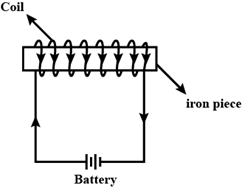
4. Describe an activity to demonstrate the direction of the magnetic field generated around a current carrying conductor.
Answer: Different shapes of conductors have different type of magnetic field.
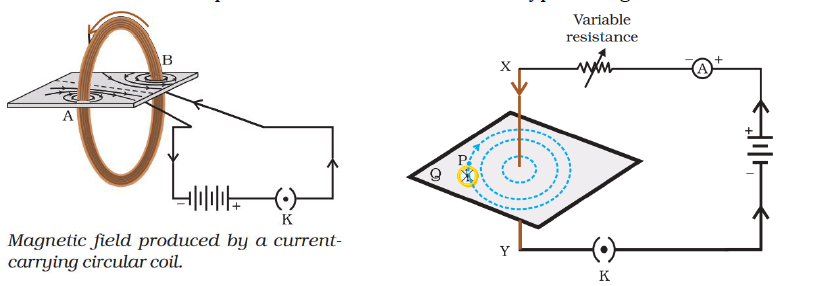
- Take a straight thick copper wire and place it between the points X and Y in an electric circuit. The wire XY is kept perpendicular to the plane of the paper.
- Horizontally place a small compass near this copper wire. See the position of its needle.
- Pass the current through the circuit by inserting the key into the plug.
- Observe the change in the position of the compass needle and the direction of deflection.
- Interchange the battery connection in the circuit so that the direction of the current in the copper wire changes.
- Observe the change in the direction of deflection of the needle.
5. Name one material used for making permanent magnets. Describe how permanent magnets are made electrically.
Answer: Iron is the material used for making electromagnets because of its magnetic properties which makes it magnetize easily and makes it able to be magnetized for longer time.
An electromagnet is made by rounding a wire and make its shape as same as solenoid which acts as a bar magnet when electric current is passed through it. If we insert soft iron core in it, its magnetic field would increase.
6. Describe an activity to draw a magnetic field line outside a bar magnet from one pole to another pole.
Answer:
- Take a small compass and a bar magnet.
- Place the magnet on a sheet of white paper fixed on a drawing board, using some adhesive material.
- Mark the boundary of the magnet.
- The south pole of the needle points towards the north pole of the magnet.
- The north pole of the compass is directed away from the north pole of the magnet.
- Mark the position of two ends of the needle.
- Now move the needle to a new position such that its south pole occupies the position previously occupied by its north pole.
- In this way, proceed step by step until you reach the south pole of the magnet.
- Join the points marked on the paper by a smooth curve. This curve represents a field line.
- These lines represent the magnetic field around the magnet. These are known as magnetic field lines.
- Observe the deflection of the compass needle as you move it along the field line. The deflection increases as the needle is moved towards the pole.
7. (a) What is the function of an earth wire in electrical instruments? Why is it necessary to earth the metallic electric appliances?
(b) Explain what is short-circuiting and overloading in an electric supply.
(c) What is the usual capacity of the fuse wire in the line to feed:
(i) Lights and fans?
(ii) Appliances of 2 kW or more power?
Answer: (a) The main function of earth wire is to absorb excess electricity passing through the appliance and to prevent overloading of live wire. The metallic appliances are earthed because whenever there is leakage of current, the leaked current passes through the earth wire to earth.
(b) Short Circuit – When live wire comes in contact with Neutral wire then the resistance becomes zero and with Ohm’s law current becomes infinite.
Overloading – When a large number of home appliances are connected simultaneously to same socket and they withdraw large amount of current than mentioned on the switch.
(c) Fuse wire is a safety measurement used in case of overloading, short-circuiting or high voltage from the electricity board.
(i) The usual capacity of the fuse wire in the line to feed lights and fans is around 15-20 A or less.
(ii)The usual capacity of the fuse wire in the line to feed appliances of 2 kW or more power is a minimum of 30 A but it is preferred to have 50-60 A or less.
8. The diagram below shows a coil connected to a Centre zero galvanometer G. The galvanometer shows a deflection to the right when the N-pole of a powerful magnet is moved to the right as shown.
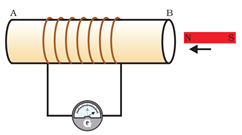
(i) Explain why the deflection occurs in the galvanometer.
(ii) Does the direction of current in the coil appear clockwise or anticlockwise when viewed from end A?
(iii) State the observation in G when the coil is moved away from N.
(iv) State the observation in G when, both coil and the magnet, are moved to the right at the same speed.
Answer: (i) The deflection in the galvanometer occurs because of change in magnetic flux linked with the coil which results in formation of induced emf and further induced current due to the phenomena called electromagnetic induction.
(ii) The direction of current appears to be anti-clockwise from point A because at point A there is formation of North pole and at point B there is formation of South pole.
(iii) When the coil is moved away from north pole the direction of induced current gets reversed because point A now becomes South pole and point B now becomes North pole due to change in magnetic flux linked with the coil. So, the galvanometer will show deflection to the left side.
(iv) There would be no observation change in galvanometer as the magnet and closed coil are moving with same speed and have no relative motion. For formation of induced emf, there must be relative motion between magnet and coil.
9. The figure shows a long solenoid, a cylindrical coil of a number of turns of insulated copper wire, connected to a battery through an ammeter A and a rheostat Rh.
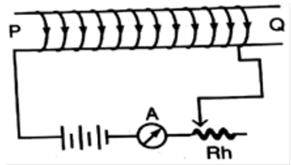
(i) Which end of the solenoid is an N-pole and which end is an S-pole?
(ii) Draw the magnetic field lines inside the solenoid and indicate their directions. Are magnetic field lines closed?
(iii) How can you increase the strength of the magnetic field inside the solenoid? Give two methods.
Answer: (i) Point P is the South pole and point Q is the North pole because of the specified direction of the current flowing in the solenoid and by using right-hand thumb rule our thumb points towards point Q, so it is North pole.
(ii) Yes, magnetic field lines form closed loops and inside the solenoid they go from south to north pole and outside the solenoid it goes from north to south pole.
(iii) By looking at the formula for magnetic field i.e., B = μonI of solenoid we can say the two methods for increasing magnetic field are:
(a) By increasing the number of turns per unit length.
(b) By increasing the amount of current passing through it.
10. (a) What is meant by a magnetic field?
(b) How is the direction of magnetic field at a point determined?
(c) Describe an activity to demonstrate the direction of the magnetic field generated around a current carrying conductor.
(d) What is the direction of magnetic field at the Centre of a current carrying circular loop?
Answer: (a) Magnetic field is the area in which the magnetic strength of a magnet can be felt by a magnetic material, inside this field the magnet can either attract or repel the magnetic substances.
(b) We can determine magnetic field direction by using magnetic compass by placing it at that point and observing the needle’s direction.
(c)
- Take a straight thick copper wire and place it between the points X and Y in an electric circuit. The wire XY is kept perpendicular to the plane of the paper.
- Horizontally place a small compass near this copper wire. See the position of its needle.
- Pass the current through the circuit by inserting the key into the plug.
- Observe the change in the position of the compass needle and the direction of deflection.
- Interchange the battery connection in the circuit so that the direction of the current in the copper wire changes.
- Observe the change in the direction of deflection of the needle.
(d) The direction of magnetic field depends upon the direction of current passing through that circular loop. If the current is flowing clockwise then the direction of magnetic field is inside the loop along the axis and vice versa.
11. Two circular coils P and Q are kept close to each other, of which coil P carries a current. What will you observe in the galvanometer connected across the coil Q,
(a) if current in the coil P is changed?
(b) if both the coils are moved in the same direction with the same speed?
Give reason to justify your answer in each case.
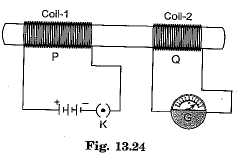
Answer: (a) If current in the coil P [Fig. 13.24] is increased, we get momentary deflection in galvanometer connected across the coil Q in one direction. However, if current in the coil P is decreased, the deflection in galvanometer is in opposite direction. Due to change of current in coil P, the magnetic filed of coil Q also changes and so as induced current is set up in coil Q and the galvanometer shows a deflection.
(b) If both the coils P and Q are moved in the same direction with the same speed, the magnetic field of both the coils remain unchanged. Hence no induced current is set up in coil Q and there is no deflection in the galvanometer.
12. What is the function of a galvanometer in a circuit?
Answer: A galvanometer is used to detect the flow of current, if any, in a circuit.
13. One of the major causes of fire in office buildings is short-circuiting. List three reasons which may lead to short-circuiting. How can it be prevented?
Answer: Three possible reasons of short-circuiting of an electrical circuit are as follows:
(i) The insulation of electrical wirings is damaged.
(ii) The electrical appliance used in the circuit is defective.
(iii) A n appliance of higher power rating is being run on an electrical line of lower power rating.
Short-circuiting can be prevented by the use of electrical fuse of appropriate capacity.
14. What is an electric fuse? Briefly describe its function.
Or
Explain the use of electrical fuse. What type of fuse material is used for fuse wire and why?
Answer: An electric fuse is a device which is used ahead and in series of an electric circuit as a safety device to prevent the damage caused by short-circuiting or overloading of the circuit.
It is a small, thin wire of a material whose melting point is low. Generally wire of tin or tin- lead alloy or tin-copper alloy is used as a fuse wire. If due to some fault electric circuit gets short-circuited, then a strong current begins to flow. Due to such strong flow of current the fuse wire is heated up and gets melted. As a result, the electric circuit is broken and current flow stops. Thus, possible damage to the circuit and appliances is avoided.
15. (a) List four factors on which the magnitude of magnetic force acting on a moving charge in a magnetic field depend.
(b) How will a fine beam of electrons streaming in west to east direction be affected by a magnetic field directed vertically upwards? Explain with the help of a diagram mentioning the rule applied.
Answer: (a) Magnitude of magnetic force acting on a moving charge in a magnetic field depends on
(i) the magnitude of charge,
(ii) speed of moving charge,
(iii) strength of magnetic field, and
(iv) the angle between the direction of motion of charge and the direction of magnetic field.
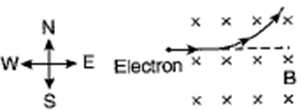
(b) The electron streaming from west to east is equivalent to a current from east to west. The magnetic field B is vertically upwards and shown by cross marks (x). Hence, in accordance with Fleming’s left hand rule, the electron will experience a force in north direction and deflected in that direction.
16. What is a solenoid? Draw magnetic field lines due to a current – carrying solenoid. Write three important features of the magnetic field obtained.
Answer: A solenoid is a coil of large number of circular turns of wire wrapped in the shape of a cylinder. On passing electric current, a magnetic field is developed. Magnetic field lines are drawn below. The field is along the axis of solenoid such that one end of solenoid behaves as north pole and the other south pole. Thus, field of a solenoid is similar to that of a bar magnet.
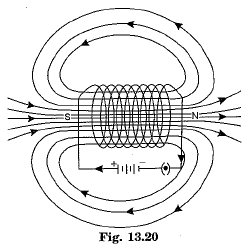
Important features of magnetic field due to a current-carrying solenoid are:
(i) Magnetic field lines inside the solenoid are nearly straight and parallel to its axis. It shows that magnetic field inside a solenoid is uniform.
(ii) Magnetic field of solenoid is identical to that due to a bar magnet with one end of solenoid behaving as a north pole and other end as a south pole.
(iii) A current-carrying solenoid exhibits the directive and attractive properties of a bar magnet.
17. Describe an activity with a neat diagram to demonstrate the presence of magnetic field around a current-carrying straight conductor.
Answer: Take a long straight thick copper wire and insert it through the centre of a plane cardboard. Cardboard is fixed so that it is perfectly horizontal and the thick wire is in vertical direction.
Prepare an electric circuit consisting of a battery, a variable resistance, an ammeter and a plug key.
Connect the copper wire in the circuit between the points X and Y. Sprinkle some iron-filings uniformly on the cardboard. Put the plug in key K so that a current flows in the circuit.
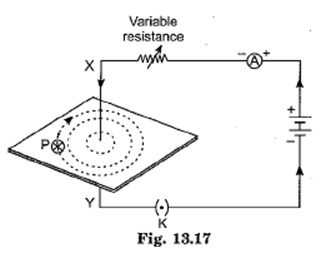
Gently tap the cardboard using a finger. We observe that the iron-filings align themselves forming a pattern of concentric circles around the copper wire.
These concentric circles represent the magnetic field lines. Direction of field lines is determined by the use of a compass needle. If current is flowing vertically downward then the magnetic field lines are along clockwise direction. If current is flowing vertically upward then the field lines are along anticlockwise direction.
18. (a) Describe an activity to draw a magnetic field line outside a bar magnet from one pole to another pole.
(b) What does the degree of closeness of field lines represent?
Answer: (a) Take a bar magnet and place it on a sheet of white paper fixed on a drawing sheet. Mark the boundary of magnet. Take a small compass and place it near the north pole of the magnet. Mark the position of two ends of compass needle. Move the needle to a new position so that its south pole occupies the position previously occupied by its north pole. In this way proceed step by step till we reach the south pole of magnet. Join the points marked on the paper by a smooth curve. This curve represents a magnetic field line as shown in Fig. 13.15.
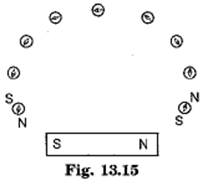
(b) The degree of closeness of magnetic field lines signifies the strength of magnetic field.
19. What type of current is given by a cell?
Answer: Direct current (D.C.).
20. Write any one method to induce current in a coil.
Answer: Whenever magnetic field around a coil is changed, a current is induced in the coil.
21. Under what condition is the force by a current-carrying conductor placed in a magnetic field maximum?
Answer: The force acting on a current-carrying conductor placed in a magnetic field is maximum when the direction of current is at right angles to the direction of the magnetic field.
22. Define magnetic field of a bar magnet.
Answer: The magnetic field of a bar magnet is the region around the magnet in which force due to magnet can be felt.
23. What is the shape of magnetic field lines due to a straight current-carrying conductor?
Answer: Magnetic field lines form concentric circles around the conductor with conductor at the centre.
24. What are magnetic field lines?
Answer: A magnetic field line around a magnet is the path along which north pole of a magnetic compass needle points. A magnetic field line gives the direction of magnetic field at a point.
25. (a) Describe an activity to show that an electric current-carrying wire behaves like a magnet.
(b) Write the rule which determines the direction of magnetic held developed around a current-carrying straight conductor.
Answer: (a) Take a straight, thick copper wire X Y and connect it in an electric circuit consisting of a battery, key and a resistor. Place a small compass near the copper wire. Now put the plug in key K so that a current begins to flow. The compass needle is deflected.
It shows that the current-carrying copper wire is behaving like a magnet.
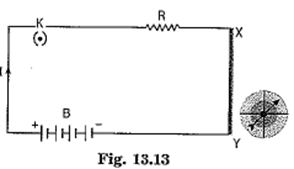
(b) The direction of magnetic field around a straight current-carrying conductor is given by “right- hand thumb rule”. According to the rule, imagine holding the current-carrying straight conductor in your right-hand such that the thumb points towards the direction of current. Then the fingers of right-hand wrap around the conductor in the direction of the field lines of the magnetic field.
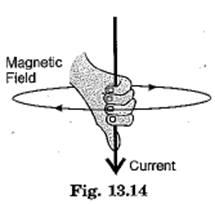
26. Out of the three wires live, neutral or earth, which one goes through ON/ OFF switch?
Answer: The live wire.
27. Why does a current-carrying conductor experience a force when it is placed in a magnetic field?
Answer: A current-carrying conductor produces a magnetic field around it. This magnetic field interacts with the externally applied magnetic field and as a result the conductor experiences a force.
28. What is the frequency of A.C. being supplied in our houses?
Answer: 50 Hz.
29. Distinguish between a direct current and an alternating current.
Answer:
| Alternating Current | Direct Current |
| AC is safe to transfer longer distance even between two cities, and maintain the electric power. | DC cannot travel for a very long distance. It loses electric power. |
| The rotating magnets cause the change in direction of electric flow. | The steady magnetism makes DC flow in a single direction. |
| The frequency of AC is depended upon the country. But, generally, the frequency is 50 Hz or 60 Hz. | DC has no frequency of zero frequency. |
| In AC the flow of current changes its direction backwards periodically. | It flows in a single direction steadily. |
| Electrons in AC keep changing its directions – backward and forward | Electrons only move in one direction – that is forward. |
30. Describe an activity to explain how a moving magnet can be used to generate electric current in a coil.
Or
A coil made of insulated copper wire is connected to a galvanometer. What will happen to the deflection of the galvanometer if a bar magnet is pushed into the coil and then pulled out of it? Give reason for your answer and name the phenomenon involved.
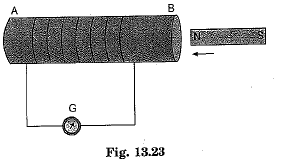
Answer: Take a coil AB of insulated copper wire having a number of turns. Connect the ends of coil to a sensitive galvanometer G. Now take a bar magnet NS and rapidly bring the magnet towards the end B of coil as shown in Fig. 13.23. The galvanometer gives momentary deflection in one direction. Now take the magnet away from the coil, the galvanometer again gives momentary deflection but in the opposite direction. It clearly shows that motion of magnet induces, a current in the coil.
Again keep the magnet fixed and gently move the coil AB either towards the magnet or away from the magnet. We get deflection in galvanometer even now. Thus, an induced current is produced in a coil whenever there is relative motion between the coil and the magnet. This phenomenon is known as the electromagnetic induction.
31. A metallic conductor is suspended perpendicular to the magnetic field of a horse-shoe magnet. The conductor gets displaced towards left when a current is passed through it. What will happen to the displacement of the conductor if the:
(i) current through it is increased?
(ii). horse-shoe magnet is replaced by another stronger horse-shoe magnet?
(iii) direction of current through it is reversed?
Answer: (i) On increasing the current flowing through metallic conductor, the force experienced by it is proportionately increased because F ∝ I.
(ii) On using a stronger horse-shoe magnet the magnetic force increases because F
(iii) On reversing the direction of current the direction of force is reversed and conductor is displaced towards right instead of left direction.
32. For the current carrying solenoid as shown below, draw magnetic field lines and giving reason explain that out of the three points A, B and C at which point the field strength is maximum and at which point it is minimum.

Answer: Outside the solenoid magnetic field is minimum. At the ends of solenoid, magnetic field strength is half that of inside it. So Minimum – at point B; Maximum – at point A
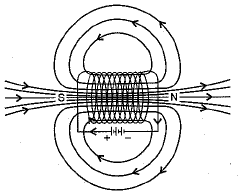
33. What is meant by solenoid? How does a current carrying solenoid behave? Give its main use.
Answer: Solenoid: A coil of many circular turns of insulated copper wire wound on a cylindrical insulating body (i.e. cardboard etc.) such that its length is greater than its diameter is called solenoid.

When current is flowing through the solenoid, the magnetic field line pattern resemble exactly with those of a bar magnet with the fixed polarity North and South pole at its ends and it acquires the directive and attractive properties similar to bar magnet. Hence the current carrying solenoid behaves a bar magnet.
Use of current carrying solenoid: It is used to form a temporary magnet called electromagnet as well as permanent magnet.
34. What are magnetic field lines? Justify the following statements
(a) Two magnetic field lines never intersect each other.
(b) Magnetic field lines are closed curves.
Answer: Magnetic field lines: It is defined as the path along which the unit North pole (imaginary) tends to move in a magnetic field if free to do so.
(a) The magnetic lines of force do not intersect (or cross) one another. If they do so then at the point of intersection, two drawn tangents at that point indicate that there will be two different directions of the same magnetic field, i.e. the compass needle points in two different directions which is not possible.
(b) Magnetic field lines are closed continuous curves. They emerge out from the north pole of a bar magnet and go into its south pole. Inside the magnet they move from south pole to north pole.
35. Draw magnetic field lines produced around a current carrying straight conductor passing through a cardboard. Name, state and apply the rule to mark the direction of these field lines. How will the strength of the magnetic field change when the point where magnetic field to be determined is moved away from the straight conductor? Give reason to justify your answer.
Answer:
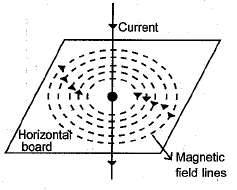
Right-Hand Thumb Rule. This rule is used to find the direction of magnetic field due to a straight current carrying wire.
It states that if we hold the current carrying conductor in the right hand in such a way that the thumb is stretched along the direction of current, then the curly finger around the conductor represent the direction of magnetic field produced by it.
Using compass needle, we can determine the strength of magnetic field at various point. If the needle is moved away from the straight wire carrying constant current, the deflection in the needle decreases. It implies that magnetic field strength decreases as the distance increases.
36. (a) What are magnetic field lines? How is the direction of magnetic field at a point in a magnetic field determined using field lines?
(b) Two circular coils ‘X’ and ‘Y’ are placed close to each other. If the current in the coil ‘X’ is changed, will some current be induced in the coil ‘Y’? Give reason.
(c) State ‘Fleming’s right hand rule.
Answer: (a) It is defined as the path along which the hypothetical unit N-pole tends to move in a magnetic field, if free to do so.
By drawing a tangent at that point on the magnetic field lines one can find the direction of magnetic field at that point.
(b) Yes, of the current in coil X is changed, the magnetic field associated with it also changes around the coil ‘Y’ placed close to ‘X’. This change in magnetic field lines linked with ‘Y’, according to Faraday law of electric magnetic induction, induces a current in the coil Y.
(c) Right-Hand Thumb Rule. This rule is used to find the direction of magnetic field due to a straight current carrying wire.
It states that if we hold the current carrying conductor in the right hand in such a way that the thumb is stretched along the direction of current, then the curly finger around the conductor represent the direction of magnetic field produced by it. This is known as right-hand thumb rule.
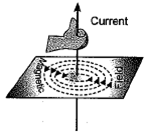
Direction of Field Lines due to current carrying straight conductor as shown in figure.
37. (a) State Fleming’s left hand rule.
(b) Write the principle of working of an electric motor.
(c) Explain the function of the following parts of an electric motor.
(i) Armature
(ii) Brushes
(iii) Split ring
Answer: (a) Fleming’s Left-Hand Rule: Stretch the thumb, forefinger and middle finger of the left hand such that they are mutually perpendicular to each other. If the forefinger pointed towards the direction of magnetic field and middle finger in the direction of current, then the thumb will indicate the direction of motion or force experienced by the conductor. It is to be applied only when the current and magnetic field, both are perpendicular to each other.
(b) Principle of an electric motor: It works on the principle of magnetic effect of current. When a current carrying conductor is placed perpendicular to the magnetic field, it experiences a force. The direction of this force is given by Fleming’s left hand rule.
(c) (i) Armature: It consists of a large number of turns of insulated current carrying copper wires wound over a soft iron core and rotated about an axis perpendicular to a uniform magnetic field supplied by the two poles of permanent magnet.
(ii) Brushes: Two conducting stationary carbonor flexible metallic brushes constantly touches the revolving split rings or commutator. These brushes act as a contact between commutator and terminal battery.
(iii) Split ring: The split ring acts as a commutator in an electric motor. With the help of split ring, the direction of current through the coil is reversed after every half of its rotation and make the direction of currents in both the arms of rotating coil remains same. Therefore, the coil continues to rotate in the same direction.
38. A current-carrying conductor is placed in a magnetic field. Now answer the following:
(i) List the factors on which the magnitude of force experienced by conductor depends.
(ii) When is the magnitude of this force maximum?
(iii) If initially this force was acting from right to left, how will the direction of force change, if:
(a) direction of magnetic field is reversed?
(b) direction of current is reversed? [CBSE 2016]
Answer: (i) The magnitude of force experienced by current-carrying conductor when placed in a magnetic field depends on (a) current flowing (I), (b) length of conductor (I), (c) the strength of magnetic field (b), and (d) orientation of conductor in magnetic field.
(ii) Magnitude of force is maximum when current-carrying conductor is placed at right angles to the direction of magnetic field.
(iii) (a) Direction of force is reversed that is now the force acts from left to right.
(b) Direction of force is reversed that is now the force acts from left to right.
39. In our daily life we use two types of electric current whose current-time graphs are given in Fig. 13.29.
(i) Name the type of current in two cases.
(ii) Identify any one source for each type of current.
(iii) What is the frequency of current in case
(iv) in our country?
(v) Out of the two which one is used in transmitting electric power over long distances and why?
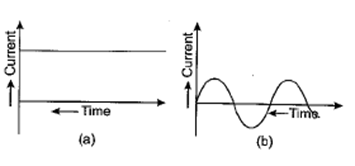
Answer: (i) Current shown in Fig. (a) is direct current (D.C.) but current shown in Fig. (6) is an alternating current (A.C.).
(ii) A cell/battery produces D.C. but an A.C. generator produces A.C.
(iii) In India frequency of A.C. is 50 Hz.
(iv) A.C. is used in transmitting electric power over long distances. It is so because transmission loss of electric power can be minimised for A.C. by employing suitable transformers at generating stations and consuming centres.
40. A student fixes a sheet of white paper on a drawing board. He places a bar magnet in the centre of it. He sprinkles some iron filings uniformly around the bar magnet. Then he taps the board gently.
Now answer the following questions:
(i) What does the student observe? Draw a diagram to illustrate your answer.
(ii) Why do the iron filings arrange in such a pattern?
(iii) What does the crowding of the iron filings at the ends of the magnet indicate?
Answer: (i) The student observes the magnetic field due to the given bar magnet. The pattern of magnetic field is shown here.
(ii) There is a magnetic field around the given bar magnet. The iron filings experience force due to the magnetic field and thus align themselves along the magnetic field lines.
(iii) The crowding of the iron filings at the ends of the magnet indicate the position of two magnetic poles N and S of given bar magnet.